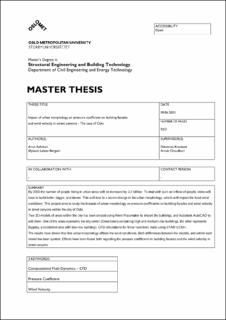Impact of urban morphology on pressure coefficient on building facades and wind velocity in street canyons: The case of Oslo
Master thesis
Published version
Permanent lenke
https://hdl.handle.net/11250/2774013Utgivelsesdato
2021Metadata
Vis full innførselSamlinger
Sammendrag
By 2050 the number of people living in urban areas will be increased by 2.5 billion. To deal with such an inflow of people, cities will have to build taller, bigger, and denser. This will lead to a severe change in the urban morphology and have impacts on the local wind conditions. Understanding how this relate will become more important in the years to come. This project aims to study the impacts of urban morphology on pressure coefficients on building facades and wind velocity in street canyons within the city of Oslo.
Two 3D-models of areas within the city has been created using Revit Placemaker to import the buildings, and Autodesk AutoCAD to edit them. One of the areas represents the city center (Downtown) containing high and medium-rise buildings. The other represents Bygdøy, a residential area with low-rise buildings. The models are limited to containing buildings where all roofs are considered flat.
These models are then imported to the CFD-tool STAR-CCM+ where a domain is created, a mesh is made, and relevant physics are applied. A simulation is then performed with the target of getting results regarding pressure coefficient of building facades and wind velocity in street canyons.
The results have shown that urban morphology affects the wind conditions in several ways. The pressure coefficient values are positive on facades facing the inlet and mainly negative on other facades. The highest magnitudes occur in exposed areas and in areas with tall buildings. It is seen that the area with low-rise buildings receives significantly smaller pressure coefficient values.
The wind velocity tends to increase around tall buildings and open areas in the Downtown model. This is more significant at the pedestrian level height (2.5m) than at 17m. There are large differences between the areas, as the Bygdøy model has very few areas with increased wind velocity.
